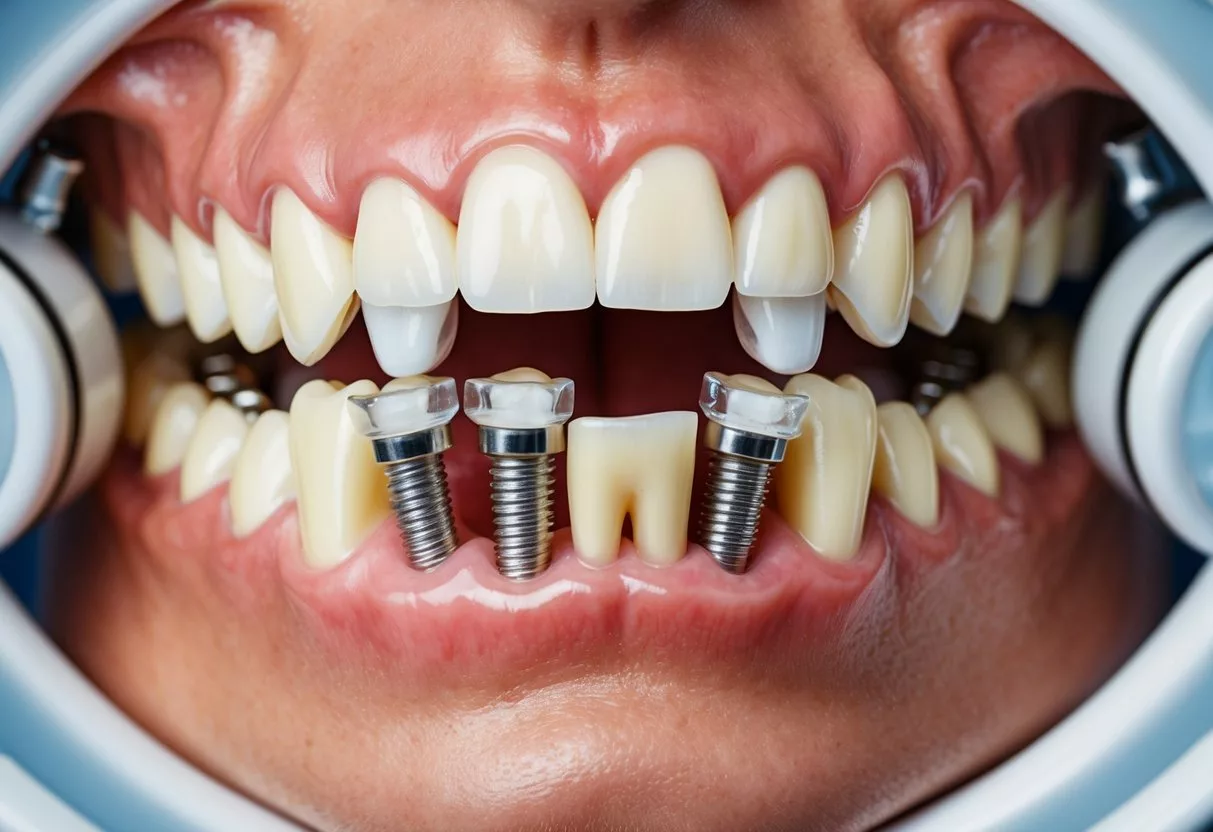Dental implants offer a long-lasting solution for missing teeth. These artificial tooth roots are placed in the jawbone to support replacement teeth.
Dental implants look and function like natural teeth. This allows people to eat, speak, and smile with confidence.

The implant process starts with surgery to insert a metal post into the jaw. After healing, an artificial tooth is attached to the post. This creates a strong, stable replacement that blends in with other teeth.
Implants can replace one tooth or many. They work well for people who have lost teeth due to injury, decay, or gum disease.
Unlike dentures, implants are fixed in place and don’t slip or move. This makes them comfortable and easy to care for over time.
Understanding Dental Implants

Dental implants are artificial tooth roots that provide a strong base for replacement teeth. They offer a permanent solution for missing teeth and can restore both function and appearance.
Components of a Dental Implant
A dental implant has three main parts: the implant, abutment, and crown.
The implant is a small titanium screw that acts as the tooth root. It’s surgically placed into the jawbone.
The abutment connects the implant to the crown. It’s attached to the implant after the bone has healed.
The crown is the visible part that looks like a natural tooth. It’s custom-made to match the color and shape of surrounding teeth.
Titanium is often used for implants because it’s strong and bonds well with bone. This process, called osseointegration, helps ensure the implant stays firmly in place.
Types of Dental Implants
There are several types of dental implants to suit different needs.
Endosteal implants are the most common. These are placed directly into the jawbone and are suitable for most patients.
Subperiosteal implants sit on top of the bone but under the gum. They’re used when patients don’t have enough healthy jawbone for endosteal implants.
Mini implants are smaller versions of standard implants. They’re often used to stabilize lower dentures or in areas with limited bone volume.
Each type has its own benefits and is chosen based on factors like jawbone density, overall health, and the number of teeth being replaced.
The Importance of Jawbone Health

A healthy jawbone is key for dental implants. It gives implants a strong base and helps them last longer. When the jawbone isn’t healthy, it can cause problems.
Jawbone and Implant Stability
The jawbone serves as the foundation for dental implants. Implants act like artificial tooth roots. They need to fuse with the bone to work well. This process is called osseointegration.
A strong jawbone helps implants stay in place. It stops them from moving or falling out. When the bone is weak, implants can become loose. This can lead to failure.
Healthy bones also help implants look natural. They support the gums and face shape. This makes the smile look better.
Bone Grafting for Insufficient Bone
Sometimes, there isn’t enough jawbone for implants. This can happen due to tooth loss or gum disease. In these cases, bone grafting may be needed.
Bone grafting adds new bone to the jaw. It can be done with:
- The patient’s own bone
- Donor bone
- Synthetic materials
This process makes the jawbone stronger and thicker. It creates a better place for implants.
Grafting can take time to heal. But it greatly improves the chances of implant success. It helps people who might not be able to get implants otherwise.
Dental Implant Procedure Overview

Dental implant surgery is a multi-step process that replaces missing teeth with artificial roots and crowns. It involves careful planning, surgical procedures, and proper aftercare to ensure successful outcomes.
Initial Dental Exam
The first step is a thorough dental examination. A dentist will take x-rays and 3D scans of your mouth to assess bone density and jaw structure. They’ll check your overall oral health and discuss your medical history.
The exam helps determine if you’re a good candidate for implants. Some patients may need bone grafting before the procedure.
The dentist will explain the process, timeline, and costs involved. They’ll also address any concerns you have about the surgery. This is a good time to ask questions about anesthesia options and pain management.
Implant Surgery Process
The actual implant placement happens in stages. First, the oral surgeon removes any damaged teeth if needed. They then drill a hole in the jawbone and insert the implant.
Most patients receive local anesthesia or sedation during the procedure. The surgery usually takes 1-2 hours per implant.
After placement, the bone needs time to grow around the implant. This process, called osseointegration, can take several months.
Once healed, the dentist attaches an abutment to the implant. Finally, they place a custom-made crown on top.
Post-Surgical Care
Proper care after surgery is crucial for healing. Patients may experience some swelling and discomfort.
The dentist will prescribe pain medication and antibiotics to manage these symptoms.
Soft foods are recommended for the first few days. Patients should avoid smoking and practice good oral hygiene.
Gentle brushing and salt water rinses help keep the area clean.
Follow-up appointments are important to monitor healing. The dentist will check for any signs of infection or complications. They’ll also ensure the implant is integrating properly with the bone.
Full recovery can take several months. During this time, patients should follow all care instructions closely to ensure the best results.
Healing and Recovery

Getting dental implants requires time for proper healing. The process involves several stages as the implant integrates with the jawbone and surrounding tissues.
Osseointegration and Healing Time
Dental implant healing centers around osseointegration, where the implant fuses with the jawbone. This crucial phase takes 3 to 6 months for most patients.
During the first week after surgery, patients may notice swelling and minor bruising around the implant site. These symptoms typically subside within 7-10 days.
The gum tissue begins to heal around the implant, forming a protective seal. This process takes about 2-3 weeks.
As osseointegration progresses, the implant becomes more stable. Patients should avoid putting pressure on the implant during this time.
Diet plays a role in healing. Soft foods are recommended for the first few weeks to avoid disturbing the implant site.
Proper oral hygiene is essential but patients must be gentle around the implant area. Dentists may recommend special mouthwashes to help prevent infection.
Full healing can take 3-6 months. Follow-up appointments allow dentists to check progress and ensure proper integration.
Benefits of Choosing Dental Implants
Dental implants offer many advantages for people with missing teeth. They look and function like natural teeth while supporting oral health.
Aesthetic and Functional Advantages
Dental implants look and feel like real teeth. They blend in with your other teeth, improving your smile and appearance.
Unlike dentures, implants stay firmly in place. This allows you to eat, speak, and laugh without worry.
Implants also help you chew food properly. They restore full biting force, letting you enjoy all your favorite foods again.
With implants, you can bite into apples or corn on the cob just like with natural teeth.
Implants support face shape too. They prevent the sunken look that can happen when teeth are missing. This helps maintain a more youthful appearance as you age.
Longevity and Durability
Dental implants are a long-lasting solution. With proper care, they can last 20 years or more. Some even last a lifetime. This makes them a cost-effective choice in the long run.
Implants are very strong and durable. They’re made of titanium, which fuses with your jawbone. This creates a sturdy foundation for replacement teeth.
Unlike natural teeth, implants can’t get cavities. But you still need to brush and floss to keep your gums healthy.
Good oral hygiene helps implants last longer.
Implants also protect your jaw bone. They stimulate bone growth, preventing loss of bone density. This helps maintain facial structure and oral health as you age.
Potential Risks and Complications
Dental implants have risks and potential problems. These can happen during surgery or later on. Patients should know about these issues before getting implants.
Common Surgical Risks
Infection is a risk with any surgery. Signs include pain, swelling, and fever. The oral surgeon will give antibiotics to prevent this.
Bleeding can occur but is usually minor. Some patients feel more pain than expected.
Nerve damage is another risk. This can cause numbness in the tongue, lips, or face. It’s rare but can be long-lasting. The surgeon must place implants carefully to avoid nerves.
Implants in the upper jaw may damage sinuses. This can lead to sinus problems. Careful planning helps prevent this issue.
Long-Term Implant Risks
Implant failure is a serious long-term risk. This happens when the implant doesn’t bond with the bone. It can occur months or years after surgery.
Signs include a loose implant or pain when biting.
Smoking raises the risk of implant failure. It slows healing and can cause bone loss. Patients who smoke may not be good candidates for implants.
Gum disease can develop around implants. This can lead to bone loss and implant failure. Good oral hygiene is key to prevent this problem.
Some patients may have an allergic reaction to the implant material. This is rare but can cause pain and swelling.
Caring for Your Dental Implants

Dental implants need proper care to last a long time. Good daily habits and regular check-ups keep implants healthy and working well.
Daily Oral Hygiene Practices
Brush implants twice a day with a soft-bristled toothbrush. Use gentle circular motions around the dental crown and gum line. Non-abrasive toothpaste helps avoid scratching the implant surface.
Floss daily with unwaxed tape or implant-specific floss. Carefully clean around the implant and under the crown. A water flosser on low setting can help remove food bits in hard-to-reach spots.
Interdental brushes clean between teeth and implants. They come in different sizes to fit various spaces. Use them gently to avoid damaging gums.
Rinse with an alcohol-free mouthwash. This helps kill bacteria and freshen breath without irritating tissues around implants.
Regular Dental Check-Ups
Visit the dentist every 6 months for cleanings and check-ups. The dentist will examine the implant, crown, and surrounding gums. They’ll look for signs of infection or loosening.
Professional cleanings remove plaque and tartar buildup. This helps prevent gum disease around implants. The dentist may use special tools designed for implant care.
X-rays check bone levels around implants. This shows if there’s any bone loss over time. Early detection allows for quick treatment if needed.
The dentist will also check bite alignment and chewing function. They’ll make sure the implant isn’t under too much stress. Adjustments can be made if needed to protect the implant.
Who is a Candidate for Dental Implants?

Dental implants can be a great option for many people with missing teeth. Several factors determine if someone is a good fit for this treatment.
Evaluating Eligibility for Implants
Good oral health is key for implant success. Candidates should have healthy gums and enough bone in their jaw to support the implant. If bone loss has occurred, a bone graft may be needed first.
Overall health matters too. People with chronic illnesses like diabetes or heart disease may face higher risks. It’s important to tell the dentist about all medical conditions.
Age isn’t usually a barrier, as long as jaw growth is complete. This typically happens by late teens.
Good candidates are committed to oral care. Daily brushing, flossing, and regular dental check-ups are crucial for implant longevity.
Considerations for Smokers and Other Conditions
Smoking can harm implant success. It slows healing and raises infection risk. Dentists often advise quitting before getting implants.
Periodontal disease must be treated before implant surgery. This gum infection can lead to implant failure if not addressed.
Some medications may affect healing. Blood thinners, for example, can increase bleeding risk during surgery.
Teeth grinding (bruxism) can put extra stress on implants. A nightguard may be recommended to protect them.
Pregnancy isn’t ideal for implant surgery. It’s best to wait until after delivery to avoid any risks to the baby.
Alternative Tooth Replacement Options

Patients have choices besides dental implants for replacing missing teeth. These options can restore smiles and chewing function while being less invasive or costly.
Bridges and Dentures
Dental bridges are fixed prosthetic devices that fill gaps left by missing teeth. They use neighboring teeth as anchors to support artificial teeth.
Bridges come in several types:
- Traditional fixed bridges
- Cantilever bridges
- Maryland bonded bridges
Dentures are removable appliances that replace multiple missing teeth. They can be partial or full, depending on how many teeth need replacing.
Partial dentures replace some missing teeth while full dentures replace all teeth in an arch. They are made of artificial teeth attached to a gum-colored base.
Benefits of bridges and dentures:
- Less expensive than implants
- Non-surgical option
- Can be made quickly
Drawbacks include:
- May not feel as natural as implants
- Require special cleaning
- Need replacement every 5-10 years
Patients should discuss all options with their dentist to find the best solution for their needs and budget.
Financial Considerations
Dental implants can be a significant investment. The cost varies based on several factors, and there are different payment options available. Insurance coverage for implants is limited but may help offset some expenses.
Cost of Dental Implant Treatment
Dental implant costs range from $1,500 to $6,500 for a single implant. Full mouth implants can cost around $15,000 per arch or more. The final price depends on:
- Number of implants needed
- Type of implant used
- Additional procedures (bone grafts, extractions)
- Dentist’s experience and location
Patients should get a detailed treatment plan and cost breakdown from their dentist. This helps avoid surprises and allows for better financial planning.
Insurance and Payment Options
Most dental insurance plans don’t fully cover implants. Some may pay for parts of the procedure, like the crown. Patients should check their policy details carefully.
Payment options for dental implants include:
- Dental savings plans
- Healthcare credit cards
- Personal loans
- In-house payment plans offered by dentists
Some patients may qualify for dental grants or financial aid. Eligibility often depends on factors like income, age, and medical history. It’s worth exploring these options to help manage the cost of treatment.
Frequently Asked Questions
Dental implants raise many common questions about cost, appearance, types, complications, recovery, and pain levels. These key aspects help patients understand what to expect when considering this tooth replacement option.
How much can I expect to pay for a full mouth of dental implants?
The cost of full mouth dental implants varies widely. Prices typically range from $25,000 to $80,000. Factors affecting cost include the number of implants needed, materials used, and additional procedures required.
Insurance may cover part of the expense, but many plans consider implants elective. Some dental offices offer payment plans to make the cost more manageable.
What should I anticipate in terms of appearance before and after dental implants?
Before implants, patients may have gaps or damaged teeth affecting their smile. After the procedure, dental implants look and function like natural teeth. The crown color is matched to surrounding teeth for a seamless appearance.
Implants can improve facial structure by preventing bone loss. This helps maintain a youthful look and avoids the sunken appearance often associated with missing teeth.
Can you describe the different types of dental implants available?
Endosteal implants are the most common type. They are placed directly into the jawbone and look like small screws. These work well for patients with healthy jawbones.
Subperiosteal implants sit on top of the bone but under the gum. They are used when patients lack sufficient healthy jawbone and cannot undergo a bone augmentation procedure.
What are some potential complications or disadvantages of dental implants?
Potential complications include infection at the implant site, injury to surrounding structures, nerve damage, and sinus problems. In rare cases, the body may reject the implant.
Disadvantages include the high cost and lengthy treatment process. Some patients may need bone grafts, adding time and expense to the procedure.
How long is the recovery period after undergoing a dental implant procedure?
The initial recovery period typically lasts 1-2 weeks. During this time, patients may experience swelling, bruising, and minor discomfort. Soft foods are recommended.
Full healing and integration of the implant with the bone can take 3-6 months. The exact timeline varies based on individual healing rates and the complexity of the procedure.
What is the typical pain level associated with receiving dental implants?
Most patients report mild to moderate discomfort after the procedure. Pain is often compared to that of a tooth extraction.
Over-the-counter pain medications are usually sufficient for management.
Local anesthesia is used during the procedure, ensuring patients feel no pain while the implant is being placed. Some experience minor soreness for a few days following surgery.
